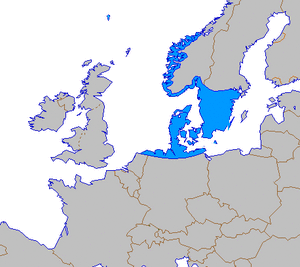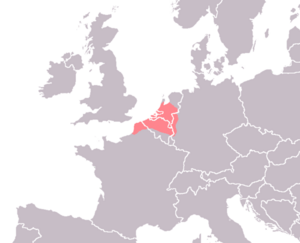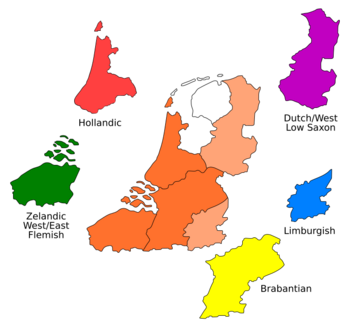History of the Dutch language facts for kids
Dutch is a West Germanic language that started from old Frankish dialects. It's spoken in the Netherlands, Belgium, Suriname, Curaçao, and Aruba.
Dutch has given English many words like brandy, cookie, easel, landscape, and yacht. Even though not many people speak Dutch compared to other languages, it has a rich literature. Dutch speakers were also very good at trade and built an empire, which helped them make a big impact on the world. It's also one of the oldest recorded languages in Europe.
Contents
Dutch and the Germanic Language Family

Dutch belongs to the Germanic languages group, which is part of the larger Indo-European language family. This means Dutch is related to languages like English, German, and the Scandinavian languages.
All Germanic languages come from a very old language called Proto-Germanic. Experts believe Proto-Germanic began around 500 BC in northern Europe during the Pre-Roman Iron Age. All Germanic languages share special sound changes, like those described by Grimm's law and Verner's law. These laws help define what makes a language Germanic.
We don't have any written records of Proto-Germanic because it was an unwritten language. We know about it by comparing modern Germanic languages. Modern Germanic languages, including Dutch, slowly developed from Proto-Germanic starting in the Early Middle Ages. The oldest Germanic writings we have are some runic script inscriptions from Scandinavia from around 200 AD. These writings are from Proto-Norse, an early form of the Scandinavian languages.
West Germanic Languages
Early Germanic dialects were divided into three main groups: West, East, and North Germanic. It's hard to know their exact relationship because we have very few old writings. However, they could understand each other to some extent during the Migration Period. This means some dialects are tricky to classify. The West Germanic group likely formed as a dialect of Proto-Germanic around the 1st century BC.
During the Early Middle Ages, the West Germanic languages started to become more distinct. This happened because of the unique development of Old English and Old Frisian in Britain, the High German consonant shift in what is now Germany, and the more traditional ancestors of Low Saxon and Old Dutch.
Frankish Language
The Frankish language, also known as Old Frankish, was spoken by the Franks. It was a West Germanic language used in parts of modern France, Germany, and the Low Countries before the 6th or 7th century. The Franks first settled in the Netherlands and Flanders before moving south and east. This language had a big impact on Old French. In the north, it developed into Old Low Franconian, which is the ancestor of Dutch. In the south, it was replaced by French. We know about Old Frankish from words borrowed into Old French and from Diets (Old Dutch).
The only direct written example of Old Frankish is the Bergakker inscription. It was found in 1996 near the Dutch town of Bergakker, close to Tiel. It's a 5th-century inscription on a metal sword scabbard.
The inscription says:
- ha?VþV??s : ann : kVsjam :
- : logVns :
The "V" is a special symbol, probably a vowel. One way to read it is: "[property] of Haþuþewaz. I bestow upon the choosers of the swords."
Old Dutch
Old Dutch is the language that came before the Low Franconian languages, including modern Dutch. It was spoken between the 6th and 11th centuries, continuing from the earlier Old Frankish language. Old Dutch did not go through the High German Consonant Shift, which changed many sounds in German. During this time, people in Franconian and Saxon areas could still understand each other's dialects. Old Dutch is considered a separate language mainly because it later led to the standard Dutch language we know today, due to political and economic reasons.
The current standard Dutch comes from Old Dutch dialects spoken in the Low Countries. The oldest identified Dutch sentence is "Maltho thi afrio lito," found in the Salic law, a Frankish document from around 510 AD. This sentence was used to free a serf (a type of servant). Other old Dutch phrases include "Visc flot aftar themo uuatare" ("A fish was swimming in the water") and "Gelobistu in got alamehtigan fadaer" ("Do you believe in God the almighty father"), written around 900 AD.
Perhaps the most famous Old Dutch text is: "Hebban olla vogala nestas hagunnan, hinase hic enda tu, wat unbidan we nu" ("All birds have started making nests, except me and you, what are we waiting for"). This was written around 1100 AD by a Flemish monk in a convent in Rochester, England.
The oldest known single Dutch word is wad, found in the place name vadam (modern Wadenoijen). It means a ford, a shallow place in a river where you can walk across. This word was mentioned in Tacitus's Histories.
Middle Dutch
Middle Dutch is a name for several related dialects spoken and written between about 1150 and 1550 in the areas where Dutch is spoken today. At that time, there wasn't one single standard language, but people speaking these dialects could probably understand each other.
In history books, Diets and Middle Dutch (Middelnederlands) are often used to mean the same thing: the ancestor of modern Dutch. Even though different Middle Dutch versions appeared early on, the dialects were quite similar, especially in written form and in the literature of that time.
Middle Dutch had five main groups of dialects:
- Flemish: Spoken in what is now West and East Flanders.
- Brabantian: Spoken in the modern Dutch province of North Brabant and the Belgian provinces of Walloon Brabant, Flemish Brabant, and Antwerp, including the Brussels area.
- Hollandic: Mainly used in the present provinces of North and South Holland and parts of Utrecht.
- Limburgish: Spoken in the modern Dutch Limburg, Belgian Limburg, and nearby parts of Germany.
- Low Saxon: Spoken in the modern provinces of Gelderland, Overijssel, Drenthe, and parts of Groningen.
The Limburgish and Low Saxon dialects could also be seen as part of Middle High German and Middle Low German based on their sounds. However, because the Dutch border later cut through these areas, the regions west of the border adopted the Dutch standard language, so they are included under Middle Dutch.
Standardization and Modern Dutch
The process of creating a standard Dutch began in the Middle Ages. This was especially influenced by the Burgundian court, first in Dijon and later in Brussels. The dialects of Flanders and Brabant were the most important during this time.
The standardization process became much stronger in the 16th century, mostly based on the city dialect of Antwerp in Brabant. In 1585, Antwerp fell to the Spanish army. Many people from Antwerp fled to Holland, which then influenced the city dialects there. The Brabantian dialect had a big impact on the development of Standard Dutch because Brabant was the most powerful region in the Netherlands when standardization began in the 16th century. The first major steps in forming standard Dutch happened in Antwerp, where a Brabantian dialect was spoken. So, the language that was developing at this time had strong Brabantian influences.
The 16th-century Brabantian dialect was quite similar to everyday Dutch. Standard Dutch has mainly developed from Brabantian and later some Hollandic dialects after the 16th century. The Standard Dutch language has changed little since the 16th century.
A very important step towards a unified language happened in 1637 when the first major Dutch Bible translation, the Statenvertaling, was published. People from all over the United Provinces could understand it. It used elements from various dialects, but its spoken form was mostly based on the city dialects from the province of Holland. A saying about this is: "The Dutch language was born in Flanders, grew up in Brabant and reached maturity in Holland."
At the same time, a similar standardization process happened in areas where High German was spoken. Eventually, all regions east of the Netherlands' political border adopted a single German standard language, breaking the dialect connections around the 19th century.
| Genesis 1:1–3 | |
|---|---|
| Dutch from 1637 | Contemporary Dutch |
| Inden beginne schiep Godt den Hemel, ende de Aerde. | In het begin schiep God de hemel en de aarde |
| De Aerde nu was woest ende ledich, ende duysternisse was op den afgront: ende de Geest Godts sweefde op de Wateren. | De aarde nu was woest en leeg, en duisternis was op de afgrond, en de Geest van God zweefde over de wateren. |
| Ende Godt seyde: Daer zy Licht: ende daer wert Licht. | En God zei: Laat er licht zijn! En er was licht. |
See also
 In Spanish: Historia del idioma neerlandés para niños
In Spanish: Historia del idioma neerlandés para niños




